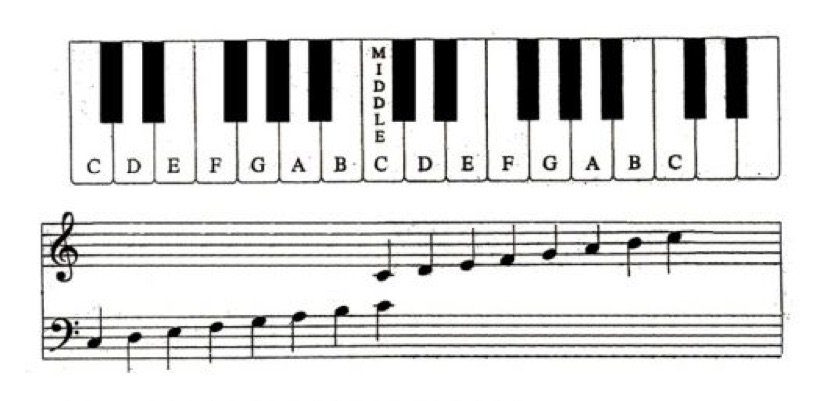

This interval is the distance between the keynote of a major scale and the seventh note of the scale, but lowered one-half step. The label “m7” on another black key represents a “minor seventh” interval. This interval is the distance between the keynote of a major scale and the sixth note of the scale, but lowered one-half step. The label “m6” on another black key represents a “minor sixth” interval. This interval is the distance between the keynote of a major scale and the third note of the scale, but lowered one-half step. The label “m3” on the second black key represents a “minor third” interval. It’s the distance between the keynote of a major scale and the second note of the scale, but lowered one-half step. The label “m2” on the first black key represents a “minor second” interval. These represent minor intervals, one-half step below major intervals. You’ll notice on the graphic there are some black keys with lower-case “m’s” and numbers on them. Major intervals are the intervals between the keynote of a major scale and the second, third, sixth and seventh notes of the scale.

This interval is the distance between the keynote of a major scale and the eighth/final note of the scale. This stands for a “Perfect 8th” interval, also known as an “Octave”. This interval is the distance between the keynote of a major scale and the fifth note of the scale. This stands for a “Perfect 5th” interval. This interval is the distance between the keynote of a major scale and the fourth note of the scale. This stands for a “Perfect 4th” interval. The fourth note on the graphic has a “P4” on it. This interval is the distance between the keynote of a major scale and the first note of the scale - the same note. That “P1” stands for a “Perfect 1st” interval, also known as a “Unison”. If we look at the graphic, we can see the keynote C (the starting note of the scale) has a “P1” on it. (If you’re wondering whether we should count the black keys when we count intervals, great question! We’ll look at that in a minute.) Interval Types We label the interval a “second” because we label it by the number of the upper note. Intervals are distances between notes, counted from low to high, labeled by the number of the upper note.įor example, a C to a D is an interval of a second, because a C to a D is a distance of two notes. The piano takes on new life! Intervals Defined If you understand the intervals used to build a particular kind of chord, you can apply that pattern starting on any key. They matter because in order to build a piano chord from the ground up, you need a healthy knowledge of intervals. If you haven’t yet read Understanding the Circle of Fifths, be sure to go back and read through that before moving on to piano intervals. Learning piano chords starts with understanding piano intervals.


 0 kommentar(er)
0 kommentar(er)
